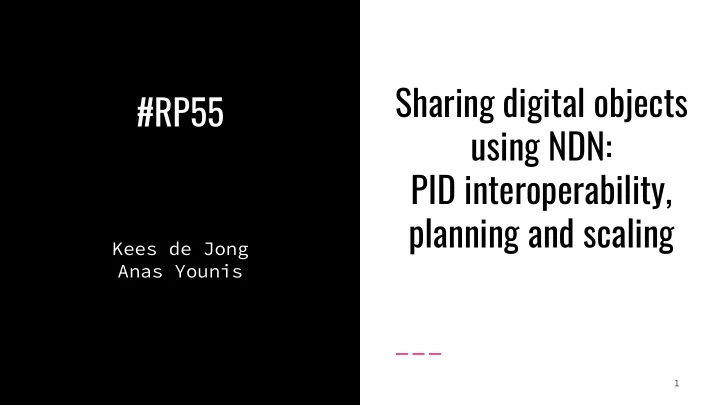

Sharing digital objects #RP55 using NDN: PID interoperability, planning and scaling Kees de Jong Anas Younis 1
SeaDataCloud SeaDataCloud is a distributed marine data infrastructure ● network in different geographical domains 8 institutes with over 100 data centers ○ Aiming to make research data available to scientists ○ Sharing large data sets becomes a challenge ● Congestion ○ Interoperability ○ 2
SeaDataCloud Figure 1: Current SeaData cloud setup 3
SeaDataCloud Figure 2: Potential solution 4
Research question How to make the Persistent Identifier (PID) and NDN ● (Named Data Networking) namespace interoperable ? How to support different PID types? ○ How to incorporate extensibility for future PID schemes? ○ How to plan and scale an NDN network? ● Which NDN scaling problems are known? ○ Which method can be used to plan an NDN network? ○ How to deploy an NDN network in a scalable way? ○ 5
Outline Short introduction about NDN and PID ● Related work ● System architecture and virtualized NDN functions ● PID interoperability ○ Virtual NDN planning, automation and scaling ○ Experiment results ● Conclusion and future work ● 6
Why NDN? NDN is the most mature variation of ICN ● ICN = Information Centric Networking ○ ndn-cxx solution was used in our proof of concept ○ Forwarding based on name prefixes rather than IP ● No end-to-end connections needed ○ Data cached on intermediary hops ○ Figure 3: IP versus NDN 7
PID types 8
Related work Rahaf Mousa ● Focused on DOI > NDN ○ Concluded that PID > NDN is possible ■ Most optimal caching strategy in NDN ○ Andreas Karakannas ● For every PID type a PID > NDN mapping server ○ States: ○ "PID > NDN mapping will be highly depended on the clients ■ NDN browser which will need to be updated every time new rule would be appeared or changed" Spiros Koulouzis et al. ● NaaS4PID ○ Supports one PID type ■ 9
PID → NDN namespace interoperability Translation is transparent to the user ● Support for multiple PID types ● Extensible with future PID types with different naming ● schemes Handle: [http://hdl.handle.net/] 20/5000/481/objects/example_object NDN: /ndn/handle/20/5000/481/objects/example_object URN: [http://resolver.kb.nl/resolve?urn=] anp:1938:10:01:2:mpeg21 NDN: /ndn/urn/anp/1938/10/01/2/mpeg21 10
PID → NDN model Figure 4 11
Proof of concept 12
How to make NDN scalable and software definable? Kubernetes ● ○ Open-source container-orchestration system Deployment ■ Scaling ■ Management ■ SDN-style control ● Centrally deploy and configure containers (NDN functions) ○ Add roles (routers) ■ Configure routes ■ Allocate resources ■ 13
Architecture drawing - Proof of concept Figure 5 14
How to plan the NDN network The challenge becomes ● How to manage/plan/deploy such a diverse infrastructure? ○ Single description to plan and deploy needed ● Is there an open standard available? ○ 15
How to plan the NDN network (TOSCA) What is TOSCA? ● Topology and Orchestration Specification for Cloud Applications ○ Declarative Domain Specific Language (YAML/XML) ○ TOSCA descriptions → orchestrator ○ Used to describe complete lifecycle ○ Hosts (bare metal, VM, containers) ■ Software components (applications, databases, middleware) ■ Network components (load balancers, gateways, VNF’s) ■ TOSCA is agnostic towards orchestrators ● DRIP ○ OpenStack ○ And gaining popularity ○ 16
Difgerent types in TOSCA to describe building blocks Node ● ● Eight different types to use Host, container , VM , etc. ○ Node ○ Relationships ● Relationships ○ Connects nodes to each other ○ Artifacts ○ dependsOn , hostedOn, connectsTo ○ Capabilities ○ Interface ● Interface ○ Groups ○ Set of hooks ○ Policies ○ Actions to: Create , configure, ○ Data ○ start, stop or delete 17
Figure 6: TOSCA diagram 18
How to make NDN software definable? (Kubernetes) spec: hostname: ndn-router-1 nodeName: mulhouse containers: - image: aqual1te/ndn:router3 name: ndn-router1 env: - name: gateway value: ndn-producer-2 - name: routes value: /ndn/handle /ndn/ark - name: protocol value: tcp 19
20
Demo 21
Conclusion Deployment planning ● TOSCA can describe complete lifecycle of infrastructure ○ Easy scaling out to other clouds ● VM’s used to allocate/deallocate resources in the cloud ○ Kubernetes used to scale in/out the application (NDN) ○ Bringing data closer to the user decreases latency and chance of ○ congestion Interoperability between different PID types is possible ● Adding new PID types is low effort cost ○ 22
Future work TOSCA blueprints are conceptual ● The VM and Kubernetes was deployed manually ○ Full implementation developed needed with an orchestrator such as ○ e.g. DRIP NDN is still experimental ● Explore performance bottlenecks (benchmarking) ○ Test routing protocols (e.g. OSPFN) ○ Extent Kubernetes with intelligence ● Where to deploy NDN routers (containers)? ○ Incorporate the PID → NDN translation into NDN software ● natively 23
Questions? 24
Performance of proof of concept setup TODO: Graphs of NDN vs TCP/IP (boxplot or barplot) ● TODO: Explain why the performance differs ● 25
Performance of proof of concept setup 26
Performance of proof of concept setup Difference in percentage ● 100MB file: ○ NDN (UDP) vs PID (TCP/IP): 27% ■ NDN (TCP) vs PID (TCP/IP): 150% ■ NDN (TCP) vs NDN (UDP): 98% ■ 1000MB file: ○ NDN (UDP) vs PID (TCP/IP): 18% ■ NDN (TCP) vs PID (TCP/IP): 24% ■ NDN (TCP) vs NDN (UDP): 5% ■ 27
28
NDN performance bottlenecks Named data forwarding scaling ● ● Underlay (TCP/IP) Routing table sizes ○ UDP vs TCP ○ Forward strategies ○ MTU sizes ○ Named data caching scaling ● Processing problems in software ● Cache strategies + size ○ Slow packet decode functions ○ LCE (Leave Copy ■ (35.4% time spend on decoding) Everywhere) Long names can degrade ○ Cache replacement strategies ○ performance 29
Recommend
More recommend